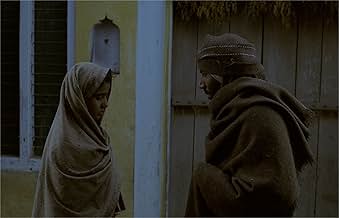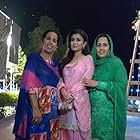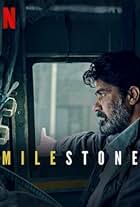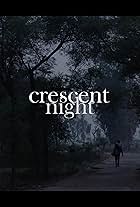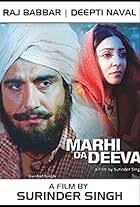IMDb RATING
7.1/10
322
YOUR RATING
A day in the life of a family in a village in Punjab as they deal with social and labor trials and inequities, leading to a night of a lunar eclipse.A day in the life of a family in a village in Punjab as they deal with social and labor trials and inequities, leading to a night of a lunar eclipse.A day in the life of a family in a village in Punjab as they deal with social and labor trials and inequities, leading to a night of a lunar eclipse.
- Awards
- 2 wins & 2 nominations
Dharminder Kaur Maan
- Mother
- (as Dharminder Kaur)
Storyline
Featured review
Gurvinder Singh's Punjab is unlike what we have ever seen.Its very far removed from the yellow mustard fields with farmers doing the Bhangra. The mustard fields do crop up here, but only as a reference to a few stalks of mustard which have been denied to an old woman who works the whole day in the rich landlords cotton farms.She is accused of ruining the farm and comes home angry and bitter.She tells her husband that in the old days they used to give some mustard stalks away to the poor and get blessed in return.But this film is not about de-glamorizing Punjab.
Gurvinder Singh makes a film based on a 1976 novel by Gurdial Singh but the story of a low- caste family forever condemned to a life of hardship and marginalization remains fresh even today.Punjab is that shiny state where the green revolution made ordinary farmers very rich and industrialists much richer.I clearly remember a geography class in school when our teacher told us a big secret,"The farmers in Punjab have TV's and refrigerators, some even have cars".In the mid eighties of India when such things were not even ubiquitous among the urban middle class this was a big revelation.This was confirmed in Dilwale Dulhania Le Jayenge where we were treated to an agrarian utopia which was only disturbed by a benign form of male chauvinism.
Anhe Ghore Da Daan bears the stamp of Mani Kaul who along with Kumar Sahani tried to start a formalist approach to cinema against an overwhelmingly Bollywoodised backdrop and punctuated by the Indian new wave of which Satyajit Ray was the standard bearer.Mani Kaul's teacher was Ritwick Ghatak but Kaul decided to make films very unlike his beloved teachers.Instead he turned to the French master Robert Bresson for inspiration and made the path breaking Uski Roti(1970) which left the audiences angry and alienated with its stubborn refusal to tell a story, communicating entirely with its measured images and mood.
Melu Singh at a Dhaba which is nothing like the ones that people in luxury cars stop at for a taste of Punjab. As the film begins we see a house being demolished.It belongs to a low-caste landless farm worker.The land on which it stood had been tilled by him for decades but the landlord has now sold it to an industrialist.An old man who lives with his wife and two young children watches the tragedy with sad haunted eyes.His face speaks for the whole community which has nowhere to turn to.They form a group and go to the upper caste village headman house where they are reminded of their place in society. In fact they belong to the lower castes that have won reservation in government jobs.None of the characters here have produced civil servants.There appears to be a further class divide among them, ever harder to surmount. When we see him first, the face of this old man(Mal Singh) lying on a cot, his long white hair not yet tied into a neat turban,with a blank distant look, tells a story that does not need a narrative.
We meet his two sons, living in the city apparently away from this class divide. Melu(Samuel John Sabastien) on which the film centers is a rickshaw puller, his backbreaking work is numbing him.His two fellow rickshaw pullers point out the meaninglessness of his life, he does not drink while they find succor in a bottle of hooch.There is a sequence of great cinematic power at the end where that liquor also does not work and the dream of a better life is completely shattered.All this is suggested not with dialogue which is very sparse here, but with visuals that the director and cinematographer(Satya Rai Nagpaul) create.The actors belong to the Bressonian school which believes in performances where the last trace of acting has been drained out and all we see is a real person in a situation.
This film manages to convey a multitude of issues while quietly observing a mundane slice of everyday life in the lowest echelons of Punjab society.His method is to transport us to a place and a situation and give us the time and space to interact with that reality.Mr Singh does not rush us, does not give us any message.He makes a film that is more a philosophical mediation on the medium of cinematic art than a story.That the cruel realities of the partition, crony capitalism, unequal growth, substance abuse, hopelessness and the absurdity of a caste divide are evident, is proof that if we observe these characters closely we will come head to head with these grim realities.
The faces of these women tell the story of centuries of oppression. Punjab was the worst affected after partition along with Bengal and an entire generation had to rebuild their life from scratch.The land reform that were carried out produced its own set of winners and losers. Today Punjab is one of the richest Indian states but like the rest of India it contains myriad realities.I visited the Golden Temple a few years back and despite being an atheist was struck by how serene and pure the place felt. Anhe Ghore Da Daan reminded me once again that no matter how noble the intentions of the founder of any religion, the practitioners remain solidly human and their interpretation of the religion a matter of convenient logic.This film soars much above its fertile material and is a genuine human document set to the music of supreme art of cinema. Satvinder Singh is a brave new voice of Indian cinema.
#The film is available on DVD in India in the Cinemas Of India series produced by NFDC.
@ The title of the film refers to the age old custom of asking for alms in the name of a blind horse during a lunar eclipse by members of the lower castes in Punjab.
Published on my blog mostlycinema.com
Gurvinder Singh makes a film based on a 1976 novel by Gurdial Singh but the story of a low- caste family forever condemned to a life of hardship and marginalization remains fresh even today.Punjab is that shiny state where the green revolution made ordinary farmers very rich and industrialists much richer.I clearly remember a geography class in school when our teacher told us a big secret,"The farmers in Punjab have TV's and refrigerators, some even have cars".In the mid eighties of India when such things were not even ubiquitous among the urban middle class this was a big revelation.This was confirmed in Dilwale Dulhania Le Jayenge where we were treated to an agrarian utopia which was only disturbed by a benign form of male chauvinism.
Anhe Ghore Da Daan bears the stamp of Mani Kaul who along with Kumar Sahani tried to start a formalist approach to cinema against an overwhelmingly Bollywoodised backdrop and punctuated by the Indian new wave of which Satyajit Ray was the standard bearer.Mani Kaul's teacher was Ritwick Ghatak but Kaul decided to make films very unlike his beloved teachers.Instead he turned to the French master Robert Bresson for inspiration and made the path breaking Uski Roti(1970) which left the audiences angry and alienated with its stubborn refusal to tell a story, communicating entirely with its measured images and mood.
Melu Singh at a Dhaba which is nothing like the ones that people in luxury cars stop at for a taste of Punjab. As the film begins we see a house being demolished.It belongs to a low-caste landless farm worker.The land on which it stood had been tilled by him for decades but the landlord has now sold it to an industrialist.An old man who lives with his wife and two young children watches the tragedy with sad haunted eyes.His face speaks for the whole community which has nowhere to turn to.They form a group and go to the upper caste village headman house where they are reminded of their place in society. In fact they belong to the lower castes that have won reservation in government jobs.None of the characters here have produced civil servants.There appears to be a further class divide among them, ever harder to surmount. When we see him first, the face of this old man(Mal Singh) lying on a cot, his long white hair not yet tied into a neat turban,with a blank distant look, tells a story that does not need a narrative.
We meet his two sons, living in the city apparently away from this class divide. Melu(Samuel John Sabastien) on which the film centers is a rickshaw puller, his backbreaking work is numbing him.His two fellow rickshaw pullers point out the meaninglessness of his life, he does not drink while they find succor in a bottle of hooch.There is a sequence of great cinematic power at the end where that liquor also does not work and the dream of a better life is completely shattered.All this is suggested not with dialogue which is very sparse here, but with visuals that the director and cinematographer(Satya Rai Nagpaul) create.The actors belong to the Bressonian school which believes in performances where the last trace of acting has been drained out and all we see is a real person in a situation.
This film manages to convey a multitude of issues while quietly observing a mundane slice of everyday life in the lowest echelons of Punjab society.His method is to transport us to a place and a situation and give us the time and space to interact with that reality.Mr Singh does not rush us, does not give us any message.He makes a film that is more a philosophical mediation on the medium of cinematic art than a story.That the cruel realities of the partition, crony capitalism, unequal growth, substance abuse, hopelessness and the absurdity of a caste divide are evident, is proof that if we observe these characters closely we will come head to head with these grim realities.
The faces of these women tell the story of centuries of oppression. Punjab was the worst affected after partition along with Bengal and an entire generation had to rebuild their life from scratch.The land reform that were carried out produced its own set of winners and losers. Today Punjab is one of the richest Indian states but like the rest of India it contains myriad realities.I visited the Golden Temple a few years back and despite being an atheist was struck by how serene and pure the place felt. Anhe Ghore Da Daan reminded me once again that no matter how noble the intentions of the founder of any religion, the practitioners remain solidly human and their interpretation of the religion a matter of convenient logic.This film soars much above its fertile material and is a genuine human document set to the music of supreme art of cinema. Satvinder Singh is a brave new voice of Indian cinema.
#The film is available on DVD in India in the Cinemas Of India series produced by NFDC.
@ The title of the film refers to the age old custom of asking for alms in the name of a blind horse during a lunar eclipse by members of the lower castes in Punjab.
Published on my blog mostlycinema.com
- amit_imt2002
- Mar 18, 2013
- Permalink
Details
- Release date
- Country of origin
- Language
- Also known as
- Jałmużna dla ślepego konia
- Production company
- See more company credits at IMDbPro
- Runtime1 hour 52 minutes
- Color
- Aspect ratio
- 1.85 : 1
Contribute to this page
Suggest an edit or add missing content

Top Gap
By what name was Alms for a Blind Horse (2011) officially released in Canada in English?
Answer

